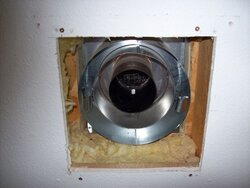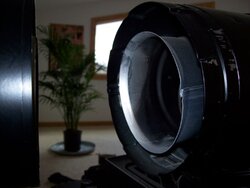This stove is a Castille by Quadra Fire. Its a gas room heater. I took apart the thimble to make sure it was ok and ready for use. Here are some pics.
It has a double wall un insulated and a 3rd sheet metal reflector. I started it up and was alarmed at the temp on the outer sleeve coming right off the stove thru the
elbow, before the thimble.It is probably ok but I am not taking any chances. I am un insured.
I want to replace the whole pipe system,direct vent, with an INSULATED either both inner and outer or at least one of them.Sorta like Duravent is to
pellet stoves.
Any ideas for this.??? The dimensions are.....inner sleeve 4" OD......second sleeve 6 7/8 OD...... 3rd reflector 9" OD note the flaired end coming off the elbow off the stovetop.The stove top goes right into an elbow 90 and then straight out into the thimble.
I wouldnt be surprised if these stoves have caused more than 1 house to burn down. Cheap, low grade engineering.seems to be the theme in America.
It has a double wall un insulated and a 3rd sheet metal reflector. I started it up and was alarmed at the temp on the outer sleeve coming right off the stove thru the
elbow, before the thimble.It is probably ok but I am not taking any chances. I am un insured.
I want to replace the whole pipe system,direct vent, with an INSULATED either both inner and outer or at least one of them.Sorta like Duravent is to
pellet stoves.
Any ideas for this.??? The dimensions are.....inner sleeve 4" OD......second sleeve 6 7/8 OD...... 3rd reflector 9" OD note the flaired end coming off the elbow off the stovetop.The stove top goes right into an elbow 90 and then straight out into the thimble.
I wouldnt be surprised if these stoves have caused more than 1 house to burn down. Cheap, low grade engineering.seems to be the theme in America.



